 
(Pines in Villa Medici)
|
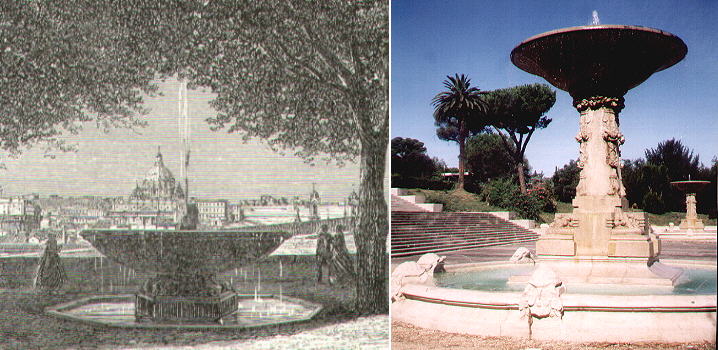 | ||
The fountains chosen by Respighi were:
the fountain of Valle Giulia at dawn (Andante mosso)
the Tritone fountain by Gian Lorenzo Bernini in the morning (Vivo, Un poco meno allegretto, Pių vivo gaiamente)
the Trevi fountain in the afternoon (Allegro moderato, Allegro vivace, Pių vivace, Largamente, Calmo)
the fountain opposite Villa Medici at sunset (Andante, Meno mosso, Andante come prima)
While the Tritone and the Trevi fountain were well known Roman landmarks, the other two fountains lacked the same celebrity.
The fountain opposite Villa Medici is made of two Roman basins and it was designed by Annibale Lippi in 1589. According to the tradition the ball from which the water sprouts is a later addition and it is a ball fired by Queen Christina of Sweden from Castel Sant'Angelo towards Villa Medici to test the cannons of the fortress.
The site of the fountain is known for its view and it has been the subject of many XIXth century paintings (the drawing above is taken from a 1903 illustrated book on Rome).
Valle (valley) Giulia is a depression between the rear part of Villa Borghese (near Giardino del Lago) and Monti Parioli, a hilly area overlooking Ponte Milvio. The site was chosen for the erection in 1911 of the Galleria Nazionale d'Arte Moderna and two fountains were located on the monumental steps leading from Villa Borghese to the gallery. When Respighi wrote his poem the area was almost out of town and the musical theme has pastoral suggestions (I do discourage going there at dawn today).
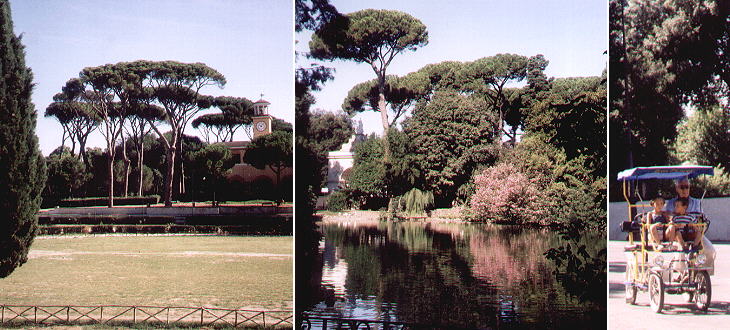 | ||
(Allegretto vivace, Pių vivo, Vivace)
In 1924 Respighi wrote a second symphonic poem, again inspired by Rome, not by its monuments but by its pines.
The first theme is dedicated to the pines of Villa Borghese and to the children who play under their shadow.
The Villa has a variety of trees. The finest pines are located around Piazza di Siena (image on the left) but many other pines can be found in its southern and western parts, while the older part of the Villa, behind the Casino, is an Italian garden with fewer pines.
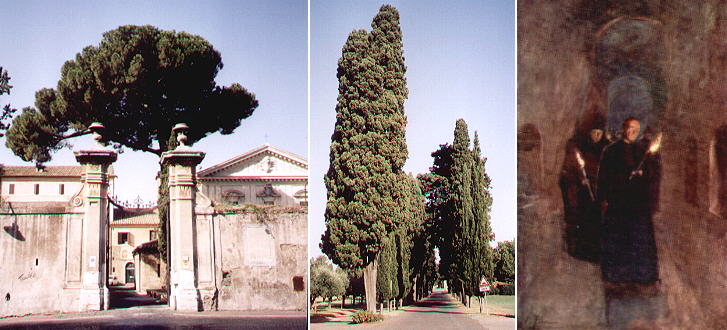 | ||
(Lento, Pių mosso, Ancora pių mosso, Poco meno, Pių lento)
The second theme is in sharp contrast with the first, Respighi abandons the joyful sounds of the children playing and moves to the pines next to a catacomb. It is not easy to locate these pines. The catacombs of S. Callisto (a property of the Holy See) have been decorated with long alleys of cypresses, chosen as a symbol of mourning. Maybe he had in mind the lonely pine at the entrance of the catacombs of S. Sebastiano.
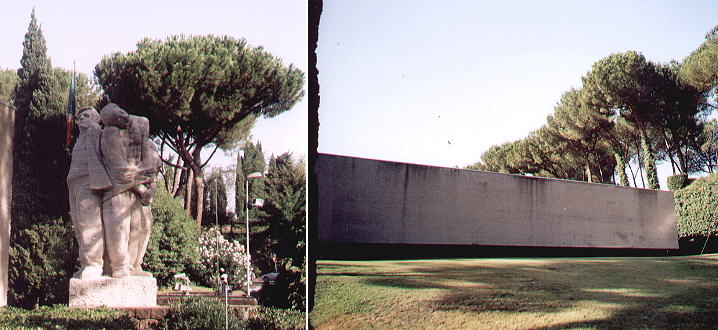 | ||
Very close to the catacombs there are other pines next to a sort of modern catacombs. In March 1944 a bomb exploded in Via Rasella, near Palazzo Barberini just as a platoon of German troops was marching by, killing 33 soldiers. In retaliation 335 Italians, either detained for political and racial reasons, or picked at random, were killed in a tufa cave (Fosse Ardeatine) near the catacombs. The heavy block covering the 335 tombs is surrounded by an impressing ring of pines.
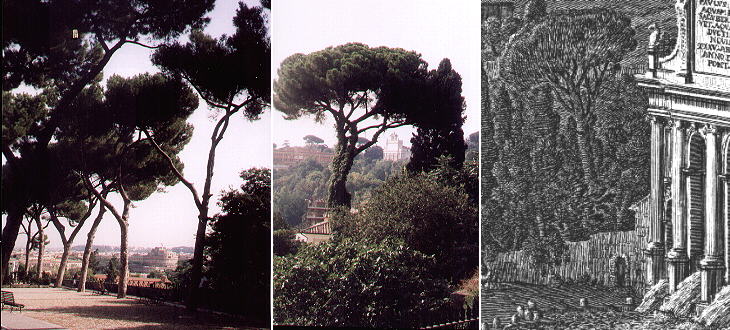 | ||
(Lento)
Pines entirely covered the Janiculum and even when the hill was divided into villas, only a fraction of them were sacrificed to the design of gardens. Villa Pamphilj was called del Bel Respiro (fine breathing) due to its many pines. In 1880-84 a modern promenade leading to the Monument to Giuseppe Garibaldi opened the Janiculum to the public. The alley was flanked by plane-trees in accordance to the then prevailing taste, but nevertheless a certain number of pines were left in place and they still frame the monuments of Rome, as they did in the 1765 Grand View of Rome by Giuseppe Vasi.
The musical theme portrays a nightingale singing from a Janiculum pine.
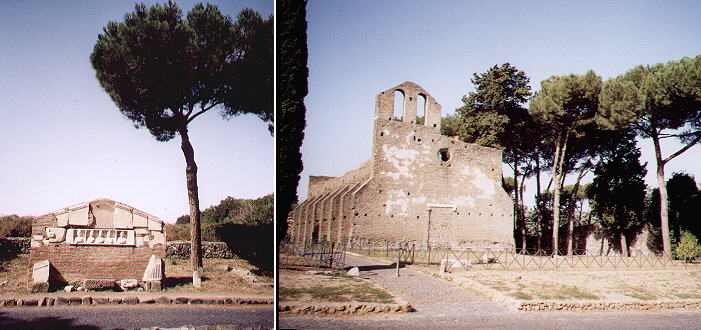 | ||
(Tempo di Marcia)
Via Appia Antica is flanked by cypresses and pines: next to many Roman tombs there is a pine and pines surround the abandoned church of S. Nicola di Bari opposite Cecilia Metella. The pines of Via Appia Antica suggested a melancholic theme, but the second and the third parts of the poem had already a very Lento movement and thus Respighi associated the pines of Via Appia Antica with the marching of the Roman legions returning from a victory in the East and he closed his work with a triumphal march. In 1924 the government of Mussolini was evolving into a totalitarian regime where the memories of Ancient Rome were exploited to support aggressive and nationalist policies. This may have influenced Respighi.
I Pini di Roma was an immediate success and in a way it consecrated the pine as the tree of Rome.
In 1976 I Pini di Roma was excellently recorded by Lorin Maazel and The Cleveland Orchestra.
In 1928 Respighi wrote his third symphonic poem describing aspects of his adopted city: Roman Festivals again made up of four parts: Circuses, Jubilee, October festival and Epiphany.
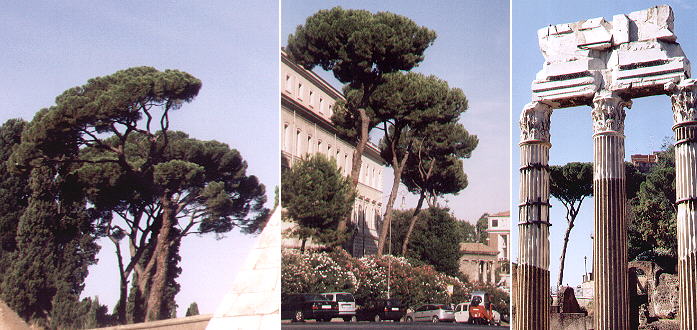 | ||
The popes had mainly used elms to embellish the largest Roman roads: some alleys leading to S. Maria Maggiore (a street near the basilica is still called Via dell'Olmata) and the road crossing Campo Vaccino were both flanked by elms. After the annexation of Rome to the Kingdom of Italy in 1870, plane-trees became fashionable and they were used for the new roads along the river.
In the 1930s it was the turn of pines to be chosen mainly to embellish the archaeological areas in the Circus Maximus, near Caracalla's Baths, the Temple of Portunus and along the ancient walls. Pines were planted in association with cypresses and oleanders, but today there are not many oleanders left. The bushes of oleanders provided a haven to those who enjoy having sex outdoors: this was tolerated in the prudish 1960s, but not in the following "liberated" years.
| Rifugio d'uccelli notturni In alto c'č un pino distorto; sta intento ed ascolta l'abisso col fusto piegato a balestra. Rifugio d'uccelli notturni, nell'ora pių alta risuona d'un battere d'ali veloce. Ha pure un suo nido il mio cuore sospeso nel buio, una voce; sta pure in ascolto, la notte. Salvatore Quasimodo 1959 Nobel Prize |
 or to
The Coats of Arms of the Popes or
to My Home Page on Baroque Rome or to
My Home Page on Rome in the footsteps of an XVIIIth century traveller
or to
The Coats of Arms of the Popes or
to My Home Page on Baroque Rome or to
My Home Page on Rome in the footsteps of an XVIIIth century traveller
All images © 1999 - 2004 by Roberto Piperno. Write to romapip@quipo.it
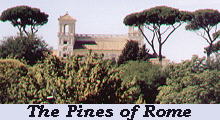 The Pines of Rome (by Ottorino Respighi)
The Pines of Rome (by Ottorino Respighi)